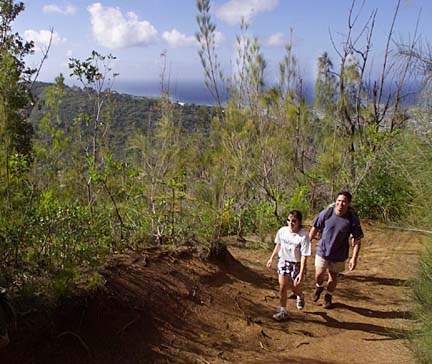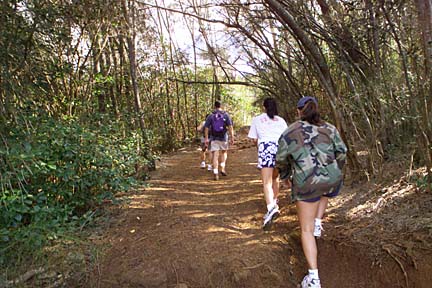


State tries to A mainland couple in their 30s -- him in running shoes and her in sports sandals -- with a water bottle in a fannypack but no rain gear, flashlight or cell phone.
grant safe passage
on trails
Forestry and wildlife officials
Clubs, safety tips
stress safety for navigating
the Hawaiian outback
By Diana Leone
Star-BulletinThat's your "average" Hawaii trail hiker on heavily used public trails, according to a survey done for the Department of Land and Natural Resources.
The survey made clear that there is a need for more hiker education -- especially about the special challenges of hiking in Hawaii, said Curt Cottrell, manager of the state's Na Ala Hele Trail program.
So Cottrell has produced a new hiker safety brochure, hot off the presses, just in time for "National Trails Day" Saturday. The brochure is available now at all DLNR wildlife offices. Eventually it may be distributed via Waikiki hotels or other tourism venues, because unprepared hikers are most often the ones who get lost.

The survey was conducted by University of Hawaii-Manoa graduate students at 14 trails on the four major islands in the fall of 2000. Though local hikers may dominate the use of other trails, the sheer volume of the folks on these trails makes the statistics important, Cottrell said. Trails surveyed included Diamond Head and Manoa Falls on Oahu, Kalalau and Awaawapuhi on Kauai, Hamakua Ditch on the Big Island and Waikamoi ridge on Maui. The Legislature earmarked $800,000 to do similar surveys of all state parks over the next two years.Excluding tour groups with a guide, the survey found that:
>> People most frequently hike in pairs (62 percent of hikers), but do sometimes go alone (17 percent).
>> Men only slightly outnumber women on the trails (51 percent to 49 percent).
>> Visitors outnumber locals almost 4-to-1, with most visitors coming from the U.S. mainland.
>> Preparedness wasn't a strong point. Just 55 percent brought water, 27 brought food and 34 percent stowed their stuff in a backpack to keep hands free.
>> About 8 percent brought each of the following: a cell phone, a map, rain gear or first aid supplies.
>> Most people's main reason for hiking was to see the view (64 percent), followed by experiencing nature (21 percent), getting exercise (20 percent), and being with a friend (5 percent).
>> Forty percent rated themselves as beginners, 46 percent intermediate and 14 percent advanced.
>> Three-quarters of hikers were on the trail where they were surveyed for the first time.
>> Though 51 percent expected hazards on the trail (such as fallen limbs or slippery spots) and 85 percent had in the past gotten lost on a trail, a majority (63 percent) didn't tell anyone they were hiking nor (75 percent) when to expect them back.
Na Ala Hele -- translated from Hawaiian as "trails to go on" -- is a system of trails maintained by the DLNR's Forestry and Wildlife Division. Its trails cover about 400 miles, or 68 percent of the trails and roads overseen by the division. They include well-known trails and little-known tracks.
By island, there are 123 miles of Na Ala Hele trails on Kauai, 91 on Oahu, 96 on Maui, and 89 on the Big Island.
The system was created in 1988 to restore recreational access to trails and to protect historic trails. The program has 11 employees and relies heavily on volunteers to keep existing trails in shape.
The Na Ala Hele trail symbol should connote "a certain level of quality, a little bit more attention to erosion control for public use," Cottrell said. He bemoans the fact that although the trails program is supposed to keep growing, its budget of $600,000 doesn't.
"In the past 10 years we've seen growing interest in public trails," Cottrell said. "When I started in '91, I didn't see any commercial operators." Now there are 19 commercial guides registered with the state. Fees charged to guides help cover some trail work costs -- but the impact of more visitors creates the need for still more maintenance.
Gwen Sinclair, who leads hikes for the Sierra Club, agreed that "Na Ala Hele doesn't have near as much money as it needs to do what they need to do with trails. It's definitely underfunded."
"On the mainland a lot of trails have signage to tell you where they go, but in Hawaii they might not have a sign," she said. "You can't tell if it's a trail or a pig trail or a trail to somebody's pakalolo patch."
Capt. Richard Soo, spokesman for the Honolulu Fire Department said long weekends are usually heavy times for rescues of all types, including mountain rescues. He said common mistakes are tourists unused to Hawaii's crumbly volcanic soil thinking they can "go to the very edge, take that one last shot for the photo album."
Soo is a proponent of hikers telling someone where they are going and when they will be back. And though he thinks taking a cell phone on a hike is a fine idea, he stresses not to let it make you cocky -- it might not work in a secluded valley.
Another warning from one who's seen many rescues: "Once night falls, just stay put. People should not try at night to work themselves out of the mountains -- even if they think they see lights." Optical illusions may cause you to misjudge distances and get yourself into a worse situation.
Soo credits the survival of two Danish women lost eight days in Kahana Valley in 1999 to their staying in one place, where they were eventually found. Soo said there were 44 mountain rescues on Oahu in 2000.
Bill Gorst, a longtime member of the Hawaii Trail and Mountain Club, said he thinks people most often get into trouble when hiking alone. Another common mistake, he said, is starting too late in the day. "I think if they are from the mainland, they don't recognize we have a very brief dusk."
"I think mainlanders tend to expect more from our trails," Gorst said. "A lot of our trails are not built trails, they're just ways that have evolved."
Mabel Kekina, trail maintenance chair for the club said, "When you're out there in the mountains, you have to be really attentive to what you're doing. We've had so many incidents where people are still missing."
The following organizations are holding special events to mark "National Trails Day" on Saturday. On the trails
Sierra Club hikes:
There will be two hikes along the Waahila Ridge. Ralph Toyama (941-0460) will lead a moderate 4-mile hike while Adam Liss (732-5660) will lead a strenuous 6-mile hike to the summit of Mt. Olympus.Both hiking groups meet at 8 a.m. at the Church of the Crossroads, 2510 Bingham St.
Sierra Club asks hikers to plan on being out all day, wear hiking boots or running shoes with good traction and bring 2 quarts of water, lunch, insect repellent and sunscreen.
The club requests donations of $1 for members and $3 for nonmembers.
Hawaii Bicycling League:
Mountain Bike Ride at Kualoa Ranch on Sunday.Registration: 7-8 a.m.
Riding: 8 a.m.-noon
Fee: $25.
The private ranch offers 7 miles of trail, with areas for beginners and advanced mountain bikers. All trails are clearly marked and maps are provided.
The Hawaii Trail and Mountain Club
The club has hikes and trail maintenance hikes most Sundays. The club can be reached at 259-5443 and puts out a quarterly hike schedule.Saturday, June 9, at 5 p.m. the club will have a potluck and slideshow at its clubhouse in Waimanalo, 41-023 Puuone St. The 7 p.m. slideshow will be "Where The Trail Meets The Air: Paragliding in Paradise."
Check out the trails on the web at www.hawaiitrails.org.
"Hiking Safely in Hawaii" is the Na Ala Hele trail system's new brochure. The brochure is available at the Department of Land and Natural Resources visitor center, Kalanimoku Building, 1151 Punchbowl St., and at each Forestry and Wildlife office on Kauai, Maui and the Big Island. Key points from the brochure include: Staying safe
>> Always tell someone where you are going and when you plan to return.
>> Hike with a partner.
>> Get information about the route.
>> Make sure your fitness and experience fit the difficulty of the trail.
>> Wear proper clothing, including hiking boots and rain gear.
>> Carry at least 2 quarts of water per person for a full-day hike.
>> Bring a daypack or waistpack with some food, a whistle, sunscreen, bug repellent, a small flashlight, basic first aid and a bright article to wave if stranded.
>> Stay on the trail.
>> Don't take risks, like climbing waterfalls or navigating narrow ridgelines.
>> Watch the weather and remember the risk of flash floods in narrow valleys.
>> Watch the time and don't get caught out after dark.
>> Don't try to travel if night falls. Settle in until morning.
>> Carry a cell phone but remember that it may be out of range in some mountain areas.